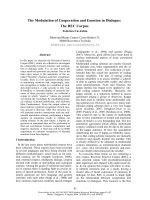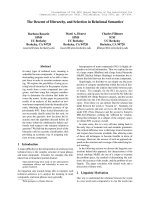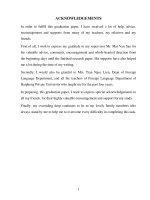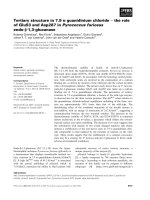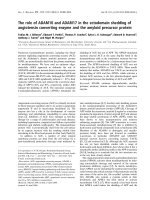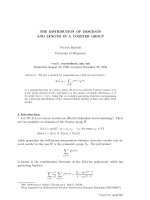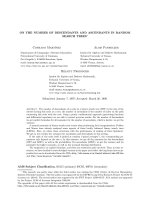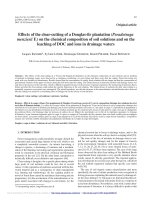The difficulties of firstyear students at Faculty of Foreign Languages, Hung Yen University of Technology and Education in rewriting English sentences
Bạn đang xem bản rút gọn của tài liệu. Xem và tải ngay bản đầy đủ của tài liệu tại đây (263.26 KB, 43 trang )
1
1
DECLARATION
I certify that this thesis is the result of my own research and the substance of this thesis has
not been submitted for a degree to any other university or institution.
Hung Yen, May 2016
Nguyen Thi Nhan
1
2
2
ACKNOWLEDGEMENTS
To complete this graduation paper, I am deeply indebted to many people for their valuable
advices and suggestions. First of all, I would like to send my heartfelt gratitude to my supervisor,
Ms. Pham Thi Duong, M.A, for her enthusiastic support, helpful advice, and considerable
encouragements in the completion of the thesis. Besides, my words of thanks are also send to the
major first year English in class TAK13.1 and TAK13.2 at Faculty of Foreign Languages UTEHY
for their enthusiastic cooperation, without their support, I would not have been able to complete this
paper. I also owe a great debt of gratitude to my family and my friends, especially my classmates in
group TAK10, who always encouraged me for such a long and hard time. Last but not least, I am
very grateful for any comments from my readers who are interested in this thesis.
2
3
3
ABSTRACT
The study deals with finding the difficulties in rewriting English sentences of major first–year
students at Faculty of Foreign Languages at Hung Yen University of Technology and Education. In
order to achieve the above mentioned objectives, the study presents the key theories related to
rewriting English sentences. The researcher carried out survey questionnaires among 77 major firstyear students at Faculty of Foreign Languages, UTEHY to get their opinions. The definition,the
formation, the seating arrangement, and the role of the learners in rewriting English sentence
lessons are also mentioned. A survey on the use of rewriting English sentence exercises at Hung Yen
University of Technology and Education are conducted in the process of doing this study. The
results of such research showed that the data analysis as well as the interpretation of the results
obtained from the questionnaires is also given. Last but not least, the study gives some difficulties
and solutions to improve students ‘ability in rewriting English sentences at Hung Yen University of
Technology and Education.
3
4
4
LIST OF ABBREVIATIONS
UTEHY: Hung Yen University of Technology and Education
FFL: Faculty of Foreign Language
MA: Master of Arts
Ss: Students
S: Student
No.1: Number
p.25: page 25
4
5
5
LIST OF TABLE
5
6
6
LIST OF CHART
6
7
7
TABLE OF CONTENTS
CHAPTER I: INTRODUCTION
1.1 Rationale
Nowadays, English has become an international language which is used officially in more
than many different countries because it is considered as an effective means of international
communication in various fields such as education and training, business and commerce, internal
relationship and diplomacy... People have different purposes to learn English, some learn to go
overseas, to satisfy their curiosity about the world outside, others learn as their major at work. As
well as, English is regarded as the key to the innovation, development and global integration.
Because of the importance of learning English, in Vietnam, it began to be used widely in
education and in daily-life activities. As a result, English has been a compulsory subject at schools,
colleges and universities. Moreover,it would know about the importance of English teaching and
learning if we understand the relations among language, grammar and vocabulary. Therefore, the
goals of English language teaching are not only to help the students learn language, but also more
importantly to use language fluently. Besides, English began to be used widely in education and in
daily-life activities. It is obviously seen that many Vietnamese students have a little experience of
writing since leaving secondary schools or colleges when they presenting written work in a daily
life. Moreover, they may be very anxious about having to write essays, letters and curriculum vitae.
Therefore, using the four language skills: listening, reading, speaking,writing, is essential to
English major students at Faculty of Foreign Languages (FFL) at Hung Yen University of
Technology and Education (UTEHY).Most writing programs are still taught using the traditional
model, emphasizing accuracy of grammatical structure and vocabulary. In addition, the formative
tests in most writing programs stress on objective-type questions, which require sentence
completion, reordering sentences, reordering words and error correction. Students have very few
actual opportunities to represent their ideas and knowledge through the written mode.
Because the students must take the test including the four language skills, writing seems to be the
most difficult but really important skill among the four skills. Moreover, writing skill access student
on writing English sentences and writing in topics; separately writing English sentences accounts
for about ten marks with five rewriting sentence. Then students pass the writing exam, all students
find that they had more difficulties in rewriting English sentences with grammar structures and
vocabulary because this course require students to write letter and rewrite English sentences . Thus,
7
8
8
it is very important to find out the effective methods in rewriting English sentences for all English
major students.
In conclusion, in order to find appropriate methods, techniques to rewrite English sentences
better, a study entitled: “The difficulties of first-year students at Faculty of Foreign Languages,
Hung Yen University of Technology and Education in rewriting English sentences” is conducted.
1.2 Aims of the study
The biggest aim of the study is to investigate the reality of difficulties and solution in
rewriting English sentences of the major first-year students at Faculty of Foreign Languages,
UTEHY. To be specific, the aims of the study are:
+ To find the factors causing the difficulties in the rewriting English sentence exercises of the
major first year students at Faculty of Foreign Languages, UTEHY.
+ To improve the inspiration of the major first year students in rewriting English sentences.
+ To recommend practical suggestions for improving rewriting English sentences of the major
first year students at Faculty of Foreign Languages, UTEHY.
1.3 Scope of study
To improve the effectiveness in rewriting English sentences of the first major year students at
UTEHY, the researcher intends to find out the difficulties in rewriting English sentences of the first
year students at UTEHY then to give some methods for improving it.Because of the limitation of
time and knowledge, the shortage of reference materials, this study cannot cover the whole issue of
writing skill.
Moreover, the study could not touch upon all the students at UTEHY. It is confined to the first
year students at Faculty of Foreign Languages, UTEHY only.
1.4 Research question
The above aims of the study are to answer the three following research questions:
1. What are the difficulties in rewriting English sentences of the first-year English major students at
Faculty of Foreign Languages, UTEHY ?
2. What are major first year students’ inspiration towards rewriting English sentence exercises Faculty
of Foreign Languages, UTEHY?
3. How to motivate for major first year students in rewriting English sentence lessons at Faculty of
Foreign Languages, UTEHY?
1.5 Methods of study
To collect the data for researching, the author used both qualitative and quantitativemethods
including questionnaires for students,teachers and interview questions for students.The interview
8
9
9
questions and the questionnaires were designed based on the main aims of the study. After getting
the results, the author used the tables and charts for presenting the collected data. The interview
results which were recorded carefully and the tape script used as another data for the analysis,
discussion and recommendation.
1.5.1 Questionnaires
Quantitative method is used and considered the most suitable to obtain the aim. The study
targets at analyzing the outcome with numbers and figures. Therefore, the data were collected by
means of questionnaires which were designed and handled to a defined population. The answers are
completely objective, not controlled by the researcher.
1.5.2 Interviews
Interview has long been accepted as an important feature in language teacher education and
supervision. By interviewing in different writing classes in the department of foreign language,
UTEHY, some interviewing data are collected and analyzed to support the process of interpreting
data.
9
10
10
CHAPTER II:LITERATURE REVIEW
2.1 Overview of teaching English grammar
2.1.1 Overview of writing
2.1.1.1 Definitions of writing
Writing has been defined in various ways by different following researchers.
Firstly, according to Brannon (1982, p.2) defines writing as a creative art, not as an assembly
line operation of locking words together into sentences and bolting sentences together into
paragraph in accordance with a predefined plan. Moreover, Byrne, (1988, p.1), writing can be
considered as an art of forming graphic symbols, that is, letters or the combination of letters on one
level, writing can be said to be the act of forming these symbols, or more clearly the act of making
marks on the flat surface of some kinds.
However, in language teaching and learning process, Tribble (1996, p.3) defines writing as a
language skill that involves “not frusta graphic representation of speech, but the development and
presentation of thought in a structured way”. According to Murray, (1987, p.29) and Perl (1979,
p.43), writing as a creative discovery procedure characterized by the dynamic interplay of content
and language: the use of language to explore beyond the known content.
From another point of view, writing is a language skill which is difficult to acquire (Tribble,
1996, p.3). Tribble also impresses that writing normally requires some form of instruction and that it
is not a skill that is readily picked up by exposure (1996,p.11). Tayor ( 1984, p.4) expressed that the
act of writing, upon examination ,and turn out to be a complex process where in writers use
language as a tool to discover and clarifying meaning on experience in order to say exactly what
they mean.
In short, in most languages, writing is a complement to speech or spoken language. Writing
is not a language but a form of technology. Within a language system, writing relies on many of the
same structures as speech, such as vocabulary, grammar and semantics, with the added dependency
of a system of signs or symbols, usually in the form of a formal alphabet; an art that writers want to
communicate with certain groups of audience to express oneself efficiently. Through the mastery of
writing, individuals come to be fully effective in intellectual organization, in the management of
everyday affairs, in the expression of ideas and arguments. Therefore, academic writing requires
conscious effort and much practice in composing, developing and analyzing ideas.
2.1.1.2 The importance of writing
10
11
11
Both in studying and working in our modern life, writing brings a lot of function, it can be
considered as an instrument for communication. When someone wants to imply a message or a
purpose, he or she can make a piece of writing. According to Nunan, 1991, p.84), writing is:
Primarily for action: public signs (on roads and station), products labels and instructions (on
food, tool, or toy purchased), recipes, maps, television and radio guides, bill, menus, telephone
directories, etc. For social contact: personal correspondence, letters, postcards, greeting cards.
Primarily for information: newspapers and magazines, non-fiction books including
textbooks, public notices, advertisements, guidebooks and travel literatures, etc.
Primarily for entertainment: light magazines, comic strips, fiction books, poetry and drama,
film subtitles, game including computer games. - Nunan (1991, p.84)
Besides, writing also plays an important role in school. We are able to share ideas, arouse
feelings, persuade and convince other people. White (1981, p.1) gives some reasons why writing
merits a place in the language syllabus:
Writing remains the commonest way of examining students performance in English (all
public examinations include a composition). Consequently, ability to write remains a key to
examination success.
In the eyes of both parents and students, ability to write may be associated with evidence of
having learnt the language. Writing is tangible- parents and students can see what have been done
and what have been achieved. So it has high “face validity”.
In the classroom, writing may be used as one of a number of techniques to help add variety and
interest to lesson.
Teachers may use writing as a testing device to provide feedback on what students have
learnt. Students’ writing can provide useful evidence of success of failures in learning, of
confusions and errors.
Writing requires thought, discipline and concentration. It is relatively a permanent form and
readers judgeus by our style, contents and logics. So writing English demands care and thought
.White (1981, p.1) said.
Moreover, Raimesdiscussed about this issue with some opinions:
Firstly, writing reinforces the grammatical structures, idioms and vocabulary that we have
been teaching our students.
Secondly, when our students write, they also have chance to be adventurous with the
language, to go beyond what they have just learnt to say, to take risks.
11
12
12
Lastly, when they write, they necessarily become very involved in the new language, the
effort to express ideas and the constant used of eyes, hands and brain are a unique way to reinforce
learning.
Moreover, Khoii (2011, p.493) emphasizes on the importance of writing skill in the field of
second and foreign language learning and teaching, learning to write fluently and correctly seems to
be of prime importance as a gate-keeping activity. Therefore, writing has many important roles not
only in studying but also in many fields in life.
2.1.1.3 Writing errors
According to Bartholomew(1980, p.255) “errors can be only understood as evidence of
intention”. In addition to that, he views errors as “one of the most marked characteristics of
sentences or utterances, which deviate from the norm of language”. Richards (1984, p.4) find that
errors can be seen as evidence of language transfer; they are “inter-systemic interference”. In
addition, Choon (1993) has the opinion that: there are some categories of errors such as semantic
error (wrong words, wrong forms, etc), grammatical errors (tense, preposition, etc) global and local
error. She suggests that “the system of classifying errors should be flexible” (p.2) and adds that
teacher can learn and decide what should be focused more in the syllabus after analyzing the
specific and common language problem their students have; she advised teacher to conduct Error
Analysis at the beginning of the course when the items have not been fully learnt and remedy these
first.
In addition, Gower and Walters (1983, p.147) suggested about a distinction between an error
and a mistake. A mistake is really a slip of the tongue or the pen. The student is able to correct it
himself, either completely unprompted or with the guidance of the teacher and other students. An
error is much more ingrained. The student might believe what he is saying is correct, not know what
the correct form should be and know what the correct form should be but cannot get it right. There
are many kinds of errors: semantics errors, grammatical errors, global and local errors. Therefore,
Hence that is why correctionis paid so much attention to in the process of teaching writing.
Generally, the definition of error is always given in connection with that of mistake.
2.1.2 Overview of teaching English grammar
2.1.2 .1 Definition of Grammar
Throughout history, Grammar is simply defined by the linguists. David Crystal defined
Grammar as “Grammar is the business of taking a language to pieces, to see how it works”.
Linguistics tries to codify or describe Grammar in term of Language Branches. They define
12
13
13
Grammar in term of phonology as sounds of language. In Morphology, they describe Grammar as
structure and forms of words. In syntax, they define it as an Arrangement of words into larger units.
In Semantics, they describe it as Meaning of language. In Pragmatics, they define it as Functions of
language and its use in context.
Chomsky in “On Nature and Language” defines grammar as the grammar of a natural
Language is a systematic description of Linguistics abilities of its native speaker, and those abilities
would enable any native speaker to speak and understand his/her language fluently. Part of these
linguistics abilities could be characterized as a native intuition or Grammatical Competence about
the sentence well sentence structure of his/ her mother tongue. A native speaker of a natural
language is able to tell whether a given sentence in his/ her mother tongue is well formed or not,
and whether a given sentence in his/ her mother tongue can be well formed in different senses, we
are concerned with its syntactic. He also points out that a native speaker grammatical judgment not
only holds for the sentence that he or she has never said or heard before, but also holds for those
that he or she has never said or heard before.. (Chomsky, 1972)
Contemporary work in comparative grammar is concerned with “a faculty of language that
provides an explanatory basic for how a human being can acquire a first language... In this way, the
theory of grammar is a theory of human language and hence establishes the relationship among all
languages(R. Freidin, 1991). The generative grammar stored in the brain that allows a speaker to
produce language that other speakers can understand. “All humans are born with the capacity for
constructing a Mental Grammar, given linguistic experience; this capacity for language is called the
Language Faculty (Chomsky, 1965) - Grammar is the mental system of rules and categories that
allows humans to form and interpret the words and sentences of their language. “A grammar
formulated by a linguist is an idealized description of this Mental Grammar.”(P.W. Culicover and A.
Nowak ,2003).
According to M.Ángeles Ecobar Álvarez, (2011, p.14), “Grammar is the system of a language.
People sometimes describe grammar as the “rule” of a language; but in fact no language has rules.
If we use the word “rule”, we suggest that somebody created the rules first then spoke the language,
like a new game. Nevertheless languages did not start like that. Language started by people making
sounds which evolved into words, phrases and sentences. No commonly-spoken language is fixed.
All languages change over time. What we call “grammar” is simply a reflection of a language at a
particular time.”
According to Thombury, (1999, p.13), grammar is:
13
14
14
A description of the rules for forming sentences, including an account of the meanings that these
forms convey; and Grammar adds meanings that are not easily inferable from the immediate
context. While Swan (P2005, p.xix), defines grammar as the rules that show how words are
combined, arranged and changed to show certain kinds of meaning.
It is probably a correct saying that there are very few inflexions in English grammar. Ithas
grown up as an easy and simplified language. Thus, Sir Philip Sidney towards the end of his essay
The Apologyie for Poetrie states that “Nay, truly, it hath that praise, that it wants not grammar; for
grammar it might have, but needs it not; being so easy in itself, and so void of those cumbersome
differences of cases, genders, moods, and tenses; which, I think, was a piece of the tower of
Babylon's curse, that a man should be put to school to learn his mother tongue” (Sidney). And he
has accepted the criticism that English has little grammar. On such an issue, George Perkins Marsh,
American philologist, in his Lectures on the English Language (1866) which was published more
than a century ago is of the opinion that English language as “having no grammar” (Marsh, p.73 ).
Grammar challenges but brings more benefit such as: for teaching concepts on subject, verb,
clause and phrases, for teaching the translation method, for teaching bilingual method, and for
teaching structural approach and traditional Methods.
It is said that knowing a language is not the same thing as knowing about it. Knowing a
language means to master four basic skills, “(a) Listening, (b) Speaking, (c) Reading and (d)
Writing” (Kohli, p.32). Here, the listening and the reading are passive skills whereas the speaking
and the writing are active skills. The Knowledge of the language makes us to know the meaning of
isolated words or sentences or the rules of grammar. Talking about the language does not mean
knowing language and using it. If we consider language as speech, as the linguists do, then knowing
a language means to use its grammatical patterns as well as proper usage.
2.1.2.2 The importance of teaching grammar
Raimes A. (1983, p.167), Grammar is important because it is the language that makes it possible for
us to talk about language. Grammar names the types of words and word groups that make
up sentences not only in Englishbut in any language. As human beings, we can put sentences
together even as children-we can all do grammar. But to be able to talk about how sentences are
built, about the types of words and word groups that make up sentences - that is
to know
about grammar. And knowing about grammar offers a window into the human mind and into our
amazingly complex mental capacity. People associate grammar with errors and correctness.
But knowing about grammar also helps us understand what makes sentences and paragraphs clear
14
15
15
and interesting and precise. Grammar can be part of literature discussions, when we and our
students closely read the sentences in poetry and stories. Knowing about grammar means finding
out that all languages and all dialects follow grammatical patterns.
Grammar rules facilitate clear and concise communication. Errors in verb tense, sentence
structure, contractions, punctuation, spelling and word usage detract from your intended message.
Being an effective communicator helps the students make a positive impression on others, which
impacts your overall happiness, social life and employment opportunities.. In fact, the American
Psychological Association suggests that the first few minutes of meeting someone shapes the course
of the relationship such as: carrier success, professional communication, personal communication,
academic achievement.
Therefore, the value of grammar teaching is important in English language teaching field.
Grammar is the base of English language. It is not acquired naturally, but learning, it needs be
instructed. Grammar operates at the sentence level and governs the syntax or word orders that are
permissible in the language. It also works at the sub sentence level to govern such things as number
and person agreement between subject and verb in a sentence. To grammar learning, some students
may have a more analytical learning style than others, but if one hopes to use English language
accurately and fluently, it is necessary for him to receive grammar rules instruction. In a short word,
grammar teaching is necessary in English language teaching.
2.1.2.3 Grammatical Error
Grammatical error is a term used in prescriptive grammar for an instance of faulty,
unconventional, or controversial usage, such as a comma splice or misplaced modifier.
“The expression ‘grammatical error’ sounds, and is, in a sense, paradoxical, for the reason that a
form cannot be grammatical and erroneous at the same time. One would not say musical discord.
Because of the apparent contradiction of terms, the form grammatical error should be avoided and
‘error in construction,’ or ‘error in English,’ etc., be used in its stead. Of course one should never
say, good grammar’ or ‘bad grammar.”’
(J. T. Baker, 1901)
2.1.2.4 Grammar Rules
In the Longman Active Study Dictionary ‘rule’ is defined as:
-
A principle order which guides behavior, says how things are to be done etc, or
The usual way that something happens
15
16
16
-
With regard to grammar, the first type of rule is often called precriptive rule and the second a
descriptive rule. For many people, grammar instruction is traditionally associated with the first type
of rules – that is, prescriptions as to what should be said or written:
+ Do not use different to and never use different than. Always use different from.
+ Never use the passive when you can use the active.
+ Use shall for the first person and will for second and third persons.
-
Second and foreign language is primarily concerned with descriptive rules, that is, with
generalizations about what speakers of the language actually do say rather than with what they
should do. Thus:
+ Do not normally use ‘the’ with proper nouns referring to people.
2.2 Overview of the feature forms in rewriting English sentence exercises
Rewrite sentences without changing the meaning
2.2.1 Phrase structure rules
In
generative-transformational
grammar
theory, phrase
structure
rules illustrate
mathematically our knowledge of how the basic units of a sentence are assembled. The theory of
phrase structure rules states that there is a limited number of rules that are carefully ordered:
+ There is a limited number of rules which serve to reflect the linguistic competence and
knowledge of a native speaker.
+ These rules are arranged in an order:
the first rule must precededthe second rule, which
must precede the third rule, etc.
+ The rules can be illustrated in phrase structure trees
+ These rules can be equated mathematically in phrase structure rules.
According to this theory, the learners can take a sentence and mathematically divide it into
parts. Chomsky explains that phrase structure rules are basically "rewriting" rules. For instance, a
sentence can be rewritten as a noun phrase plus a verb phrase. In the notation of transformational
grammar, this rule is written as:
S --> NP + VP "a sentence consists of a noun phrase followed by a verb phrase"
A sentence can be further illustrated by a phrase structure tree, like this:
Starting with this base, we can begin to build rules which will allow us to generate an infinite
number of sentences.
16
17
17
2.2.2 Run-on sentences
A run-on sentence (sometimes called a "fused sentence") has at least two parts, either one of
which can stand by itself (in other words, two independent clauses), but the two parts have been
smoothed together instead of being properly connected. Review, also, the section which describes
things that can happen between two independent clauses.It is important to realize that the length of
a sentence really has nothing to do with whether a sentence is a run-on or not; being a run-on is a
structural flaw that can plague even a very short sentence: “The sun is high, put on some sunblock”.
An extremely long sentence, on the other hand, might be a "run-off-at-the-mouth" sentence, but it
can be otherwise sound, structurally. When two independent clauses are connected by only a
comma, they constitute a run-on sentence that is called a comma-splice. The example just above
(about the sunscreen) is a comma-splice. When students use a comma to connect two independent
clauses, it must be accompanied by a little conjunction (and, but, for, nor, yet, or, so) “The sun is
high, soput on some sunscreen”.
Run-on sentences happen typically under the following circumstances:
When an independent clause gives an order or directive based on what was said in the prior
independent clause.
Two independent clauses are connected by a transitional expression (conjunctive adverb) such
as however, moreover, nevertheless.
The second of two independent clauses contains a pronoun that connects it to the first
independent clause.
2.2.3 Parallel sentence structures
Parallelism in sentences refers to matching grammatical structures. Elements in a sentence
that have the same function or express similar ideas should be grammatically parallel, or
grammatically matched. Parallelism is used as a rhetorical and stylistic device in literature,
speeches, advertising, and popular songs.
“I sighed as a lover, I obeyed as a son” – Edward Gibbon
“Reading is to the mind what exercise is to the body.” – Joseph Addison
“Ask not what your country can do for you; ask what you can do for your country” – John F.
Kennedy
Parallelism lends balance and grace to writing. It can make a sentence memorable. Even in
prose not destined for greatness, parallelism is important.
+ Faulty parallelism
17
18
18
A failure to create grammatically parallel structures when they are appropriate is referred to as
faulty parallelism. In the following examples, note the difference between correct parallel structure
and faulty parallelism.
What counts is not how to look but how you behave.
Not What counts is not how you look but your behavior.
+ Parallel structure in a series
When a sentence includes a series, make sure it has not used different grammatical structures
for the items. The elements would remain parallel even if the phrases following the gerunds were
changed or omitted. The length of the items in the series does not affect the parallel structure. It
does not matter what grammatical structure chosen for the series as long as the students keep it
consistent.
When the learners use words such as to, a, an, his, her, or their with items in a series, they can
use the word with the first item, thus having it apply to all the items; or they can repeat it with each
item. If they choose to repeat it, they must do so with all the items, not just some of them. When the
learners are comparing items in a sentence, obviously parallelism will be important. In antithetical
constructions, something is true of one thing but not another. But not and rather than are used to set
up these constructions. As with comparisons, both parts of an antithetical construction should be
parallel.
+ Parallel structure with correlative conjunctions
Errors in parallel structure often occur with correlative conjunctions: either …or; neither …
nor; both …and; not only …but also; whether …or. The sentence structure following the second
half of the correlative conjunction should mirror the sentence structure following the first half.
The scientists disputed not only the newspaper article but also the university's official
statement. (parallel: phrase with phrase). The scientists disputed not only the newspaper article but
also they disputed the university's official statement. (faulty parallelism: phrase with clause). Be
sure that any element they want to repeat appears after the first half of the correlative conjunction.
Look at the position of as in the following examples. In the second sentence, as appears
before either and is repeated after or, which makes the construction not parallel.
They acted either as individual citizens or as members of the committee.
NOT They
acted as
either individual
citizens or
as members
of
the
committee.
In the following example, the last sentence, we expected appears before the first half of the
correlative conjunction and should not be repeated after the second half.
18
19
19
We expected not only to be late but also to be exhausted.
OR We expected to be not only late but also exhausted. (better)
BUT NOT We expected not only to be late but also we expected to be exhausted.
+ Parallel structure with verbs
When the learners have more than one verb in a sentence, be sure to make the verbs parallel
by not shifting tenses unnecessarily. Also, don't shift from an active to a passive verb.Choon (1993,
p 88)
Kate prepared the speech on the plane and delivered it at the conference. (parallel: both verbs
are active)
Kate prepared the speech on the plane, and it was delivered by her at the conference. (faulty
parallelism: active verb followed by passive verb)
Sometimes sentences use a single verb form with two helping verbs. Look at the following
example.
Robert has in the past and will in the future continue to support the measure. (incorrect)
To support belongs with will continue, but not with has. If the students read the sentence
without and will in the future continue, theywill see this: Robert has in the past to support the
measure. Rewrite the sentence to include a participial form for has.
Robert has in the past supported, and will in the future continue to support, the measure.
OR Robert has supported the measure in the past, and he will continue to support it in the future.
19
20
20
CHAPTER III:THE STUDY
3.1 Methodology and data
To collect the data for researching, the author used both qualitative and quantitative methods
including questionnaires for students,teachers and interview questions for students.The interview
questions and the questionnaires were designed based on the main aims of the study. After getting
the results, the author used the tables and charts for presenting the collected data. The interview
result which were recorded carefully and the tape script used as another data for the analysis,
discussion and recommendation.
3.2 Participants of the study
Subject of this study are teachers and students from Faculty of Foreign Languages- Hung Yen
University of Technology and Education. Teaching and learning English at this university is taken
into great consideration. English is learned not as major but it is very necessary for all students in
this University as instrument; however English still plays an important role because the relation is
close to students’ major.
3.2.1 Students
Because of limited time for the graduation paper, it is impossible to implement the study with
all major students of English at UTEHY. Therefore, the data collection in the study is derived from
students who are in the first year at Faculty of Foreign Languages.
There are 77 English major students. The proportion of school boys to girls is 8/77 (the
number of male students accounted for 10% of the student population). They are at the age between
18 and 22. At present, they are on the first year at FFL, UTEHY and their major subject is English.
In addition, they come from different parts of Vietnam, but most of them are from Northern
Vietnam. At last, all of the students are studying the same course book named after “Effective
Academic Writing 1”.
3.2.2 Lectures
The second group is composed of 5 lecturers of English teaching writing skills for students at
FFL, UTEHY. These lecturers, whose ages ranged from thirties to over forties, were invited to join
this study. Their level of English proficiency is rather good. All of them are titled MA. This is one
of many advantages for English major students at UTEHY. In addition, the reason for choosing
these 5 lecturers is that they have experience in teaching English major students, especially teaching
rewriting skills.
Both students and lectures are willing and enthusiastic to take part in this study.
20
21
21
3.3 Research questions
The study has to answer the following questions to achieve its aims:
1. What are the difficulties in rewriting English sentences for the major first-year English students at
Faculty of Foreign Languages, UTEHY ?
2. What are students’inspirations towards rewriting English sentence exercises at Faculty of Foreign
Languages, UTEHY?
3. How to motivate for students in rewriting English sentence lessons at Faculty of Foreign
Languages, UTEHY?
3.4 Procedures of data collection
The data collection in the study is derived from students who are in the major first year at
Faculty of Foreign Languages. To collect information about the issues of learning rewriting skill of
first year English major students at UTEHY, first of all, 77 copies of survey questionnaires were
handed out to major first year students and 5 copies of survey questionnaires were sent to the
lecturers in FFL by email. In addition, 5 other students were also invited for the interview.
When the data collection was accomplished, the data analysis was initiated. The results of
survey questionnaires revealed students’ techniques they use in rewriting skill.
3.5 Data collection instrument
3.5.1 Questionnaire
The questionnaires were designed both for students because the researcher finds them easy to
summarize and analyze the collected data. Questionnaires for students consist of 15 questions which
are specified in the three research questions. Therefore, the survey questionnaires are in the
appendices.Questionnaire for students was delivered to 77 major first-year students of K13 at
Faculty of Foreign Languages, UTEHY to find information for the three research questions.
Among the 15 questions, the first part are designed for collecting general information of students,
questions of part II aim at finding out the students’ attitudes towards rewriting English sentences;
questions from part III mainly seek for the current techniques of teaching and learning in rewriting
English sentences for first – year students of K13 at Faculty of Foreign Languages, UTEHY.
To guarantee the reliability and the validity of the samples, the questionnaires for learners
were directly distributed for learners of K13 during their break time in the class and collected right
away. That meant these learners could pay most attention to answer the questions related to what
they had just experienced. Before asking the learners to do the survey questionnaire, the researcher
briefly stated the purpose and significance of the study and clarified any misunderstanding about the
survey questions. Beside the written instructions on the handout, oral the instructions and
21
22
22
explanations in Vietnamese were presented to avoid any ambiguity. In the end, there were 77
students participating in giving responses to the survey questionnaire.
3.5.2 The interviews
An interview is carried out with 5 students in 2 classes of K13 in Faculty of Foreign
Languages at Hung Yen University of Technology and Education. There are opened questions
designed according to the aims of the study. The data collection supplies the information about the
fact of teaching and learning in rewriting English sentences of first - year students at Faculty of
Foreign Languages this university:
+ The feelings of students about rewriting English sentences
+ The difficulties in rewriting English sentences
+ The effects of mentioned techniques
+ The recommendation techniques from students.
After the interview, the researcher based on the interview results to analyze the data. The
interview results will be recorded carefully. The interview data analysis will be presented with the
collected data from the questionnaire in each part.
3.5.3 Summary
This part presented the overview on objectives of the course, the subjects of the study, the
research questions, and instruments of data collection. The author used two different instruments:
the survey questionnaires, and interviews with the purpose of achieving more reliable, valid data. In
the next part, the author presented the data analysis and discussion for teaching and learning in
rewriting English sentences.
3.6 Data analysis, main findings and discussion
This study, as indicated in Chapter one, was intended to find out the difficulties in rewriting
English sentences of major first – year students at Faculty of Foreign Languages at UTEHY. In this
section, the data collected from the questionnaires and interviews were presented and interpreted.
3.6.1 The opinion of students in rewriting English sentences
3.6.1.1 The difficulty
The 77 copies of the questionnaire delivered to the learners. The data are analyzed in this
part of the study in the below tables and charts which show the responses for the questions in the
questionnaires. Besides, the first question the questionnaires bring a result that according to
students’ opinion, writing skill is quite difficult.
22
23
23
Chart 1: Students’ assessment on the difficulties in rewriting English sentences
Statistics collected from Chart 1 shows that the most students polled (56%) admit that
writing skill is difficult, besides 19% of them think that the rewriting English sentences is normal.
But only 22% considered that the rewriting English sentenceis very difficult. Moreover, 1%say that
the rewriting English sentences is easy. Based on the collected data from Chart 1, most of students
of K13 at FFL, UTEHY state that writing sentences is difficult but not very difficult.
Below is the result when the author asks five students the same question in the interview
Question 1: What do you think of
rewriting English sentences?
A. Very Difficult
B. Difficult
C. Normal
D. Easy
E. Very Easy
A
B
C
B
D
3Ss
60%
1S
20%
1S
20%
0S
0%
0S
0%
Table.1: The interview results of students’ assessment in rewriting English sentences
Statistics provided in Table 1 show that the interview result of students’ assessment in
rewriting English sentences, one student thinks that the rewriting English sentences is difficult, 3
students (60%) claim that the rewriting English sentences is very difficult, and only 1 students
(20%) say that rewriting English sentences is normal. Almost students think that the rewriting
English sentence is a challenged subject to them.
3.6.1.2 The importance
To research more clearly the opinion of major first-year students at Faculty of Foreign
Languages, UTEHY, the second question in the questionnaire is designed to find out their
assessment on the importance of writing.
Level of
importance
Importance
Normal
Not importance
Students
Very
importance
No.1
Rate
24
31%
No.1
40
Rate
52%
No.1
9
Rate
12%
No.1
4
Rate
5%
Lecturers
1
4
80%
0
0%
0
0%
20%
Table 2: Studentsand lecturers’ opinions on the importance of rewriting English sentences
It can be seen clearly from the table 2,the total of students agree that learning rewriting
English sentences is important as well as important is 83%. Meanwhile, there are only 5% of them
reckon that it is not important. This table shows that most of major firstyear students at Faculty of
Foreign Languages, UTEHY claim that rewriting English sentences have an important role in
23
24
24
learning English with a lot of fields in life.Furthermore, there are four lecturers accounting for 80%
of them agree that learning rewriting English sentences is important for the students.
3.6.1.3 The foundation of studying rewriting English
Foundation
Primary school Secondaryschool High school
No.1
Rate No.1
Rate
No.1
Rate
University
No.1 Rate
Students
36
Lecturers’advice3
47%
29
38%
10
13%
2
3%
60%
2
40%
0
0%
0
0%
Table 3:
Students’
foundati
on
andlectu
rers’
advice of
learning
rewriting
English
Table 3 shows the period of students at FFL, UTEHY in starting rewriting English sentences,
there are 47% students say that they begin to rewrite English sentences at primary school , 38% of
them start at secondary school. Besides,there is a minority students start at the higher education.
Meanwhile, there are 3 teachers(account for 60%)advise that students should learn rewriting
English sentences at primary school, the others said secondary school is better stage to learn this
skill. Overall, the figure 3 shows that almost students of Faculty of Foreign Languages start to learn
rewriting English sentences when they were at primary school and secondary school, in addition,
they are educated basic knowledge about rewriting English.
3.6.1.4 The inspiration
Level of
Very
inspiration
interesting
Interesting
No.1
Rate
No.1
Students
8
10%
18
Lecturers
0
0%
2
Rat
e
23
%
40
%
Normal
Boring
No.1
Rate
No.1
Rate
4
61%
2
3%
3
60%
0
0%
Very boring
No.1
Rate
2
3%
0
0%
Table 4: Students and teachers’ inspiration of (teaching) rewriting English sentences
24
25
25
Table4 shows that the inspiration on rewriting English sentences. There are 62% of students
agree that rewriting English sentences is normal. Other students (23%) strongly agree that rewriting
English sentences is interesting. There are also at the inconsideration of the last point, 6% students
feel boring and 3% of them are very bored with learning rewriting English sentences. While there
are 60 percentage of teachers feel normal with their teaching rewriting sentences, the last 40
percentage of them are interested in guiding their students in the rewriting lessons.The conclusion
for students’ inspiration of rewriting English sentences is that the major studentsand their teachers
do not have high interest in this subject.
25
